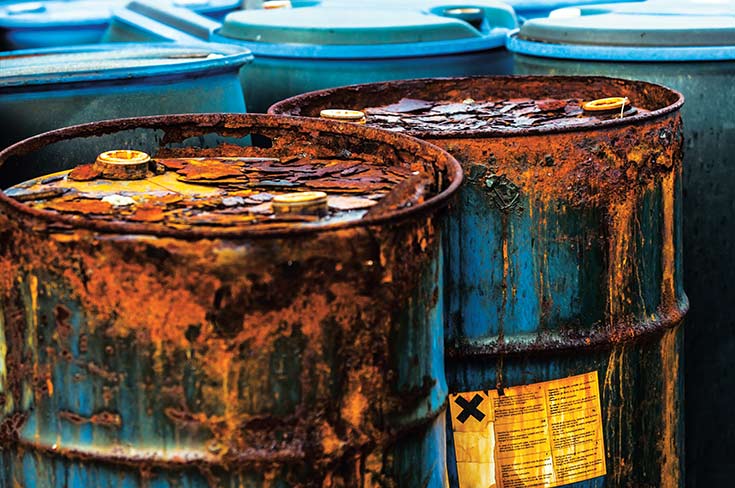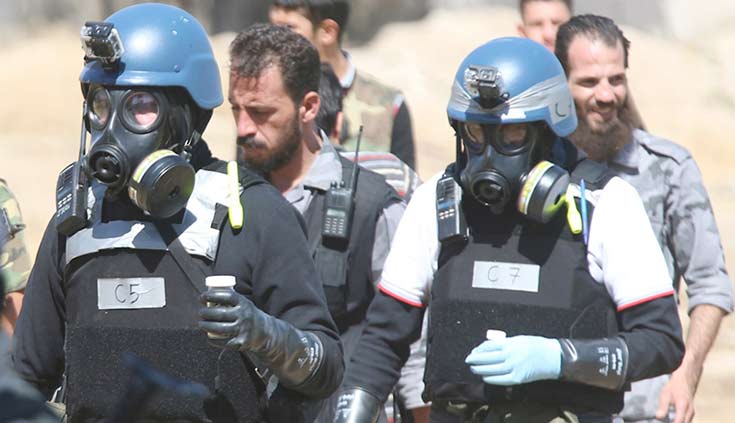Should we be concerned about the ISIL nuclear and dirty bomb threat?
The Nuclear Security Summit in Washington DC at the end of March put the threat of ISIL using some sort of fissile and/or radioactive material right at the top of the international media terror spotlight, writes Hamish de Bretton-Gordon
If ISIL could build an Improvised Nuclear Device (IND) and/or a dirty bomb it would certainly use it and would be all the better for the terrorists if this were to occur in New York, London, Paris etc. It would appear that the ISIL terror attacks in Belgium were originally planned to have some sort of nuclear element, but through good intelligence gathering and some luck this nightmare scenario was avoided – just – for now.

One concern is that nuclear weapons grade viable material could be acquired by ISIL (author photo)
It is possible that some that of the +15,000 nuclear warheads, quoted by Eric Schlosser in his recent book Gods of Metal, may be poorly guarded and could fall into terrorist hands, but it is highly improbable. Not least because at the end of the Cold War international efforts were made to secure the most vulnerable storage locations, such as the removal of 600kg of weapons-grade uranium under Project Sapphire from Kazakhstan to the US.
Also, having been involved in nuclear security in the UK, I am acutely aware of the challenges and hurdles required for a terror group to smuggle a viable device to a suitable target location successfully and then override the numerous safety features to detonate such a weapon. In my opinion the areas of concern in future are, firstly, the development of North Korea’s nuclear capability and its ‘apparent’ intercontinental ballistic missile programme, secondly, highly enriched weaponised isotopes falling into terrorist hands through the black market or dark web to build an IND, and thirdly, using commonly available radiological sources to create a dirty bomb… and in ascending order of likelihood.
I am relatively confident that the P5, and in particular the US, are keeping a very close eye on North Korea and would take offensive action if it appeared that this country was near to or about to launch some kind of nuclear tipped missile. It would appear that it (North Korea) is still some way from this at the moment.
The next concern is the possibility that nuclear weapons grade viable material is acquired by ISIL, and fashioned into an IND. Fifteen to 20kgs of Highly Enriched Uranium (HEU), with a simple ‘gun-gadget’ initiation device could yield a blast equivalent to 2,000 tonnes of TNT, which would be enough to flatten several blocks, and technically, is probably within the capabilities of ISIL’s scientists in Iraq and Syria.
I very much doubt that ISIL could explode this type of weapon in a P5 nation, except perhaps Russia. It is here that ISIL would most likely get the HEU, and it is the Chechen Jihadists who appear to be at the heart of ISIL chemical, radiological and nuclear weapons programmes. It is the Russians who are the Chechens greatest enemy and the Chechens have previously used fissile material to attack the Russian State. With this in mind it is somewhat surprising that President Putin decided to boycott the Nuclear Summit, which aims to prevent such an attack.
What the public appears most afraid off, and is the most likely threat outside Syria and Iraq from ISIL is the dirty bomb. However, the fear of a dirty bomb attack is misguided, as the only immediate casualties would likely be from the blast rather than radiation, which would be unlikely to have many short or long term medical effects. Though radiological material is relatively easy to source, the sophisticated Security Services, Counter Terror Police and Special Forces operations in the UK for example, would make it extremely unlikely that ISIL could detonate such a bomb here.

UN weapons inspectors at work in Syria (author photo)
In sum, the threat to the UK from an ISIL nuclear device is extremely low, and though only slightly higher for a dirty bomb attack, the psychological impact would out way the physiological by many times to one. Pre-warned and prepared is the best form of defence in this case.
Hamish de Bretton-Gordon is Managing Director, CBRN, at Avon Protection. He served in the British Army for 23 years, including as Commanding Officer of the UK CBRN Regiment and NATO’s Rapid Reaction CBRN Battalion. His operational deployments included the 1st Gulf War, Cyprus, Bosnia, Kosovo, Iraq and Afghanistan. In 2005 he was appointed an OBE for exceptional performance, and is one of the world’s leading experts in chemical and biological counter terrorism and warfare.
His recent work has taken him to Syria during the current conflict, advising Syria Relief on treating the victims of chemical weapons attacks. Today, de Bretton-Gordon advises senior UK Government members on CBRN. His article on Examining today’s nuclear threat landscape can be found in CRJ 11:2 (December 2015), while this commentary piece was published in The Telegraph
Hamish de Bretton-Gordon, 13/04/2016